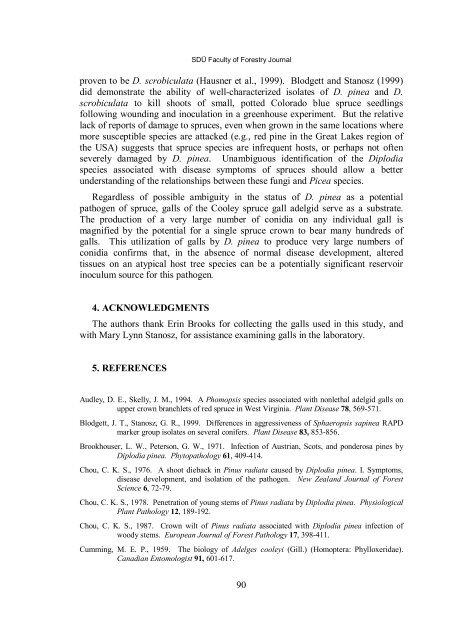sdu faculty of forestry journal special edition 2009 - Orman Fakültesi
sdu faculty of forestry journal special edition 2009 - Orman Fakültesi
sdu faculty of forestry journal special edition 2009 - Orman Fakültesi
Create successful ePaper yourself
Turn your PDF publications into a flip-book with our unique Google optimized e-Paper software.
SDÜ Faculty <strong>of</strong> Forestry Journal<br />
proven to be D. scrobiculata (Hausner et al., 1999). Blodgett and Stanosz (1999)<br />
did demonstrate the ability <strong>of</strong> well-characterized isolates <strong>of</strong> D. pinea and D.<br />
scrobiculata to kill shoots <strong>of</strong> small, potted Colorado blue spruce seedlings<br />
following wounding and inoculation in a greenhouse experiment. But the relative<br />
lack <strong>of</strong> reports <strong>of</strong> damage to spruces, even when grown in the same locations where<br />
more susceptible species are attacked (e.g., red pine in the Great Lakes region <strong>of</strong><br />
the USA) suggests that spruce species are infrequent hosts, or perhaps not <strong>of</strong>ten<br />
severely damaged by D. pinea. Unambiguous identification <strong>of</strong> the Diplodia<br />
species associated with disease symptoms <strong>of</strong> spruces should allow a better<br />
understanding <strong>of</strong> the relationships between these fungi and Picea species.<br />
Regardless <strong>of</strong> possible ambiguity in the status <strong>of</strong> D. pinea as a potential<br />
pathogen <strong>of</strong> spruce, galls <strong>of</strong> the Cooley spruce gall adelgid serve as a substrate.<br />
The production <strong>of</strong> a very large number <strong>of</strong> conidia on any individual gall is<br />
magnified by the potential for a single spruce crown to bear many hundreds <strong>of</strong><br />
galls. This utilization <strong>of</strong> galls by D. pinea to produce very large numbers <strong>of</strong><br />
conidia confirms that, in the absence <strong>of</strong> normal disease development, altered<br />
tissues on an atypical host tree species can be a potentially significant reservoir<br />
inoculum source for this pathogen.<br />
4. ACKNOWLEDGMENTS<br />
The authors thank Erin Brooks for collecting the galls used in this study, and<br />
with Mary Lynn Stanosz, for assistance examining galls in the laboratory.<br />
5. REFERENCES<br />
Audley, D. E., Skelly, J. M., 1994. A Phomopsis species associated with nonlethal adelgid galls on<br />
upper crown branchlets <strong>of</strong> red spruce in West Virginia. Plant Disease 78, 569-571.<br />
Blodgett, J. T., Stanosz, G. R., 1999. Differences in aggressiveness <strong>of</strong> Sphaeropsis sapinea RAPD<br />
marker group isolates on several conifers. Plant Disease 83, 853-856.<br />
Brookhouser, L. W., Peterson, G. W., 1971. Infection <strong>of</strong> Austrian, Scots, and ponderosa pines by<br />
Diplodia pinea. Phytopathology 61, 409-414.<br />
Chou, C. K. S., 1976. A shoot dieback in Pinus radiata caused by Diplodia pinea. I. Symptoms,<br />
disease development, and isolation <strong>of</strong> the pathogen. New Zealand Journal <strong>of</strong> Forest<br />
Science 6, 72-79.<br />
Chou, C. K. S., 1978. Penetration <strong>of</strong> young stems <strong>of</strong> Pinus radiata by Diplodia pinea. Physiological<br />
Plant Pathology 12, 189-192.<br />
Chou, C. K. S., 1987. Crown wilt <strong>of</strong> Pinus radiata associated with Diplodia pinea infection <strong>of</strong><br />
woody stems. European Journal <strong>of</strong> Forest Pathology 17, 398-411.<br />
Cumming, M. E. P., 1959. The biology <strong>of</strong> Adelges cooleyi (Gill.) (Homoptera: Phylloxeridae).<br />
Canadian Entomologist 91, 601-617.<br />
90








